
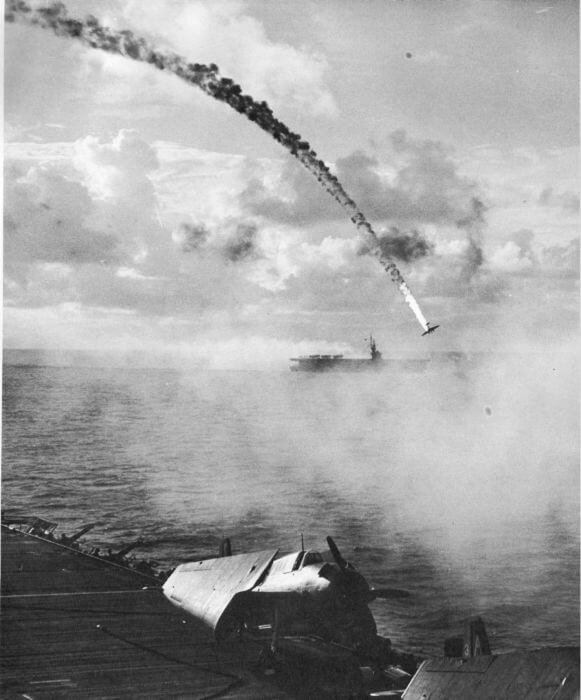
Air to Sea combat in Carrier from Victory Games
This is the first introductory scenario and is focused upon the Air battle for the Coral Sea in 1942.
So a purely mechanical exercise in airborne kinetic action. It covers – Air to Air, AA and of course the bombing runs against the ships.
The forces arrayed against each other have 2 CV’s [ Carriers ] a piece and a range of Destroyers Cruisers and battleships and other ships to provide escort. Our intent is of course to knock out the other guys CV! We would not waste attacks on non-essential ships.
The IJN have CAP of 2 steps. [CAP = aircover above ships, or Combat Air Patrol if you want to be precise]
The USN has 6 steps of CAP.
The IJN AA [Anti-Aircraft] , total factors add up to 26, but only 8 ships can participate in that action so 22 factors is the most we can gather.
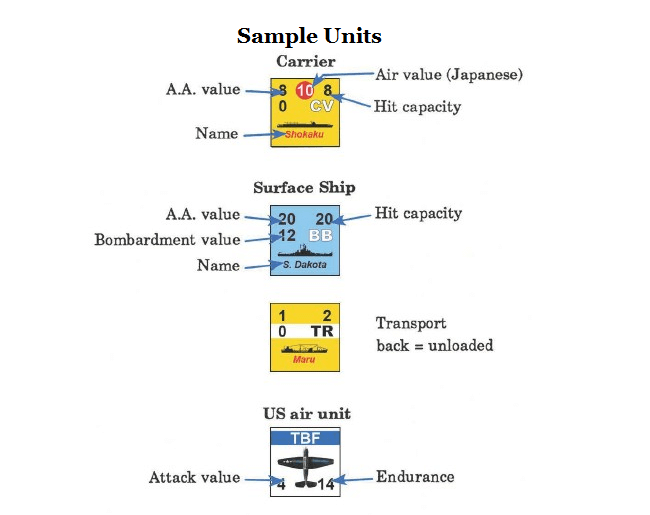
In this case everything happens simultaneously. So, we run the 2 waves of USAF and then 1 run of the abstracted Japanese bombing runs. One can imagine the fighters and bombers passing each other in the air!
The First Wave:
The IJN cap roll an 8 on the 2 column and drop 1 step of bombers. Losses must be at least half in bombers. Since they lose 1 step, we drop a TBD.
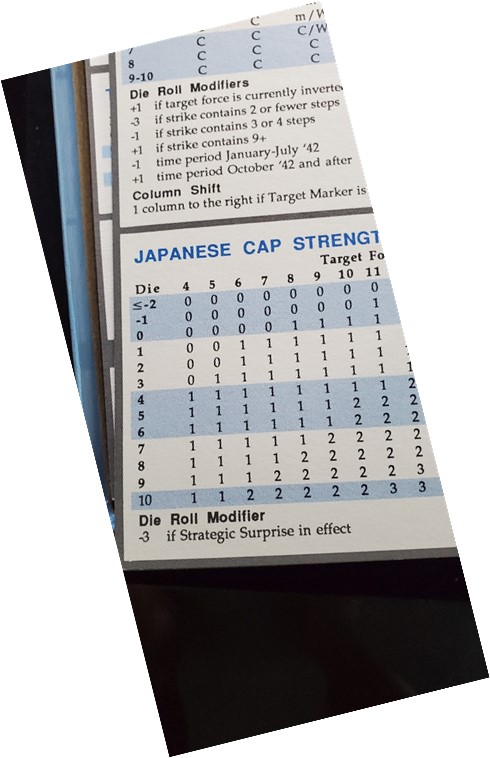
As mentioned, the AA has 22 factors and a stream of fiery metal hits the torpedo and dive bombers. The IJN get +2 for the number of steps in the attack, -1 for the date [not sure about that but does not affect end result] .
They roll a 1, plus a net 1 =2 no AA hits!
So that AA result above does give us a +1 for the incoming bombers. Meaning I think that due to the ineffectual AA, the pilots could take a bit of time, line their drops up and make the most of their runs!
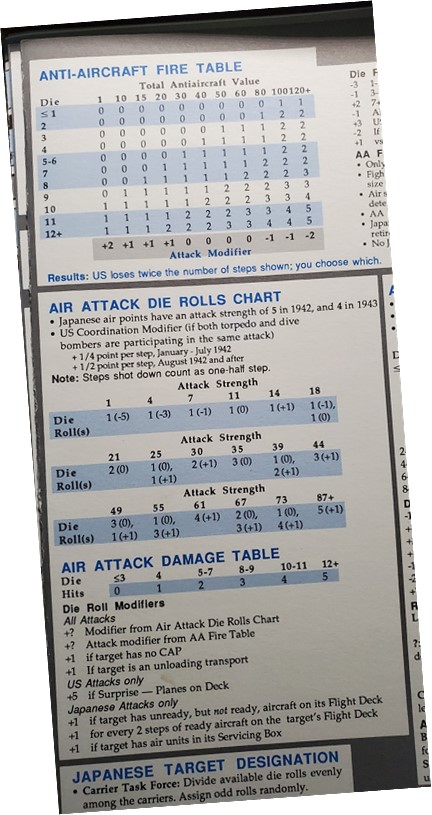
The attacks go in. No adjustments or considerations for heights or range for either side. We assume the pilots know their business.
First, we determine how many attacks [ die rolls] the US get in their first wave assault. We tally up the combat values of all involved [SBD/TBD’s] and cross reference a table called Air Attack Dire Rolls Table.
We see that we receive 1+ (0) and 1 +(1). Two attacks one of which is given a plus 1 DRM on the result table. Note that due to the ineffectiveness of the AA, both will also add another +1 DRM.
Attack run #1 rolls a 1d10 = 5 +1 for a final total of 6, We had selected prior to the roll to hit the Shokaku it takes 2 hits from a total available of 8. 25% Damage!
Attack run # 2 rolls a 1d10 and get a 6 +2 = 8 net. 3 hits. This one is targeted at the Zuikaku.
The Second Wave:
Now we repeat the above process for the 2nd wave. The Japanese CAP does no damage again. The AA inflicts a step loss on a TBD. And this time there is no bonus for the American fighters coming as the flak is much heavier this time.
The 2nd wave has 26 factors and gets the same number of attacks as above this time all the attacks are targeted at the Zuikaku. She takes 4 hits from the first run and 2 from the second sinking her!
Scratch one Flattop!!
While all this is going on the IJN strike packages are inbound….
Japanese Air Strike:
The US CAP has 8 IJN air points [note these are points not steps, there are no counters that I can see for the IJN air force] to fight. The F4F race into intercept the enemy, which will no doubt include a blend of fighters, and bombers. They roll a 9. -1 for the escort and this ends up knocking one point off the Japanese attack down to seven.
The US AA is fearsome even this early in the war. 41 factors from eight ships combine but maybe because it’s a rookie training day they fire like crap and do just 1 more point of damage, they are now down to 6 points of air attacking.
The IJN do NOT receive a DRM for the incoming strike. The IJN wisely pick the one CV and target all their efforts there. The CV Wasp, bears the brunt of the attack.
The IJN are down to 6 points. Each point has an attack strength of 5. Plus, ½ the strength of the damaged lost points a net +6. For 36 attack strength.
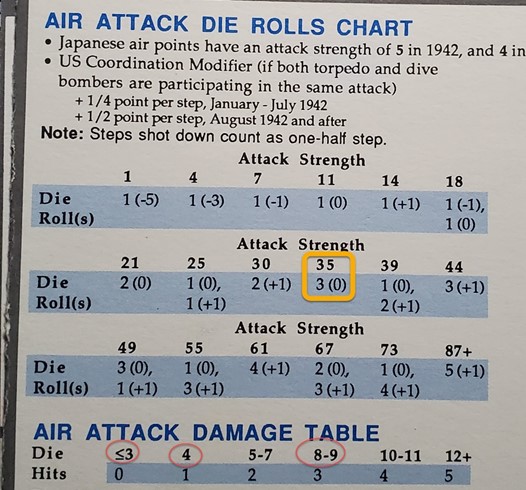
This means that the Wasp will face 3 attacks! But thankfully with no modifiers. They roll 2,4, and 8. This inflicts respectively 0,1 and 3 hits for a total of 4 hits on the Wasp. That’s 40% damage!
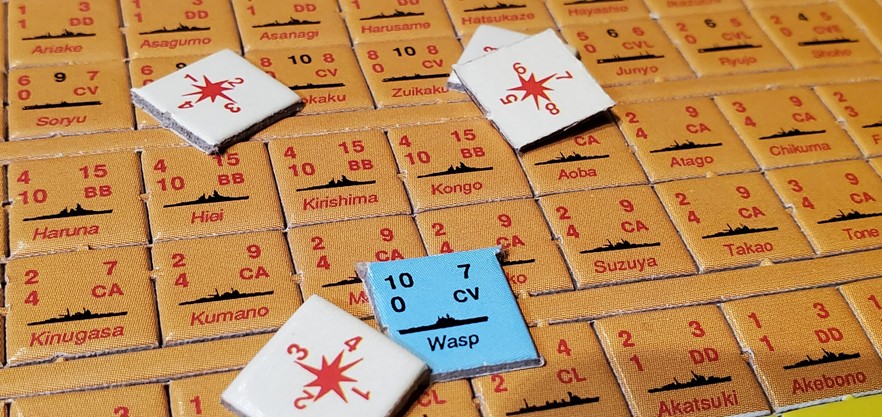
Now that is the end of the introductory scenario.
The US Navy wins because it inflicted more hits than the enemy. If you sink a carrier and the enemy sinks none you win and overwhelming victory! PLUS you get promoted! . Well that is what it says anyway.
Now this is the fundamental aspect of the game for combat air to sea. However, as we dig into the rules, we will learn about all of this stuff:
Task Force composition, Japanese Force movement, Force chits, Intel, Japanese screen, Search and Detection, surface combat etc. Then you get to add on chrome over and above that, layering in night, Japanese retirement, advance CAP, advance US air strikes and all sorts of detail.
This then to me, sits squarely in the Carrier Operations level of detail versus say aircraft vs aircraft or ‘package’ vs ‘package’ deciding on altitude, aspect etc.
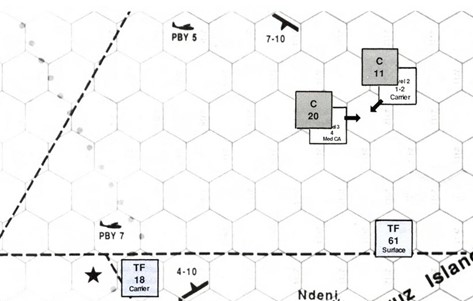
I think or suspect with this solo system you have a great deal of decisions to be making about how to search, construct strike package optimisation, a lot of unknowns regarding where your enemy is or is not and what it is you might be actually trying to attack, what is attacking you!.
As far as historical accuracy goes this seemed to be representative, but I strongly doubt in the basic game you could achieve actual historical results.

However, we can reserve judgement regarding the historical fidelity until we get deeper into the system.
Is it possible to model Pacific War operations with believable results?
I do think my primary assumption about modelling these types of Pacific theatre combats will hold true. There are so very few engagements over the course of time, that luck, mismanagement, bad timing, erroneous data, delayed data etc. play too much of a massive swing factor in most of these Sea, Air-Sea Battles to accurately reflect the Naval Combined arms experience.
Even with strong advantages for the USN from MAGIC intel decrypts the actual battles still relied on a lot of human factors, that could and did sway results. Compared to say the Battle for Britain or the European Bombing campaigns where we had 100’s if not 1,000’s of air engagements we can see ways to model pretty accurately and decide on levels of fidelity and derive close to or very close to historically accurate results [ and still maintain some level of fun, competitive play ].
Here in the Pacific we have significantly fewer major engagements and wildly varying results from each one. So, it almost seems that the more fidelity we aim for the less realistic the game becomes in the Pacific.
War in the Pacific from Decision Games is just such a game. With claims at operational grand scale, and attempts to drop down to 10 plane per counter, pilot skill levels scale with Air to Surface Tactical displays. Yet fails to deliver anything approaching the right level of results in a similar battle to the one above, even with 300+ pages of rules, charts etc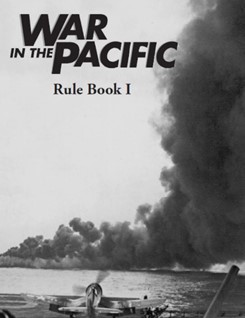 .
.
There are of course numerous other issues with WitP but the kinetic action of Air to Surface is what I am referring to specifically. Its almost as if some systems take a look at the Order of Battle, assess the mechanical and combat capabilities of each type of aircraft or bundle them up as in Carrier for the IJN and then build the CRT around that. Which is probably the correct approach…perhaps? Versus being able to [due to a paucity of data] take the results from the Coral Sea, Midway, actions around Saipan and use them to construct or reconstruct what transpired and back into a CRT of some sort.
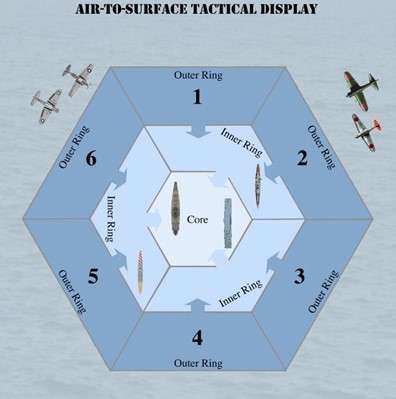
It seems Carrier at least allows for these wild swings of fortune. You might get 0 hits or FOUR! Or more. Which strikes to me at the heart of being about right.
The Pacific is a fascinating theatre, rich in detail and history for anyone who has read Toll or Hornfischer’s titles and all the lower level detailed books.
Lets keep looking together at this and other titles to find more ways to skin this wiggly cat.
Great article about a great game (“Carrier”). I look forward to reading more as you progress through additional scenarios!
Coming from you I appreciate it! You are a high bar to cross!
Carrier is the second of a trio of games from Jon Southard. Tokyo Express was first, and Jon is working on a game around the Battle of the Philippine Sea (maybe 2021).
I am moving this weekend for my new job and both Tokyo Express and Carrier are going with me (along with a number of other solo titles and some of my ASL stuff)
Great review and will be joining your two new Facebook groups.
Cheers,
Mark
Thank you Mark. I’d love to catch up with Jon at some point about his design approach.
Jon Southard is a very approachable and friendly guy. I contacted him via BGG about my redesign of this great game and he was enthusiastic about and said “use your art, make it yours and release it” (in essence). I’m curious to see what he comes up with regarding the Philippine sea game but to be honest, this early war (’42) period was very trying for the U.S. and I think it would have to make the best time period to cover but, who knows, right?
I think that to win the new game, you have to do better than the US did historically, which would be very difficult.
Did you do a revamp of Carrier? If so, where can I find it?
Cheers,
Mark
Vc say kill 1 CV, dont lose 1.